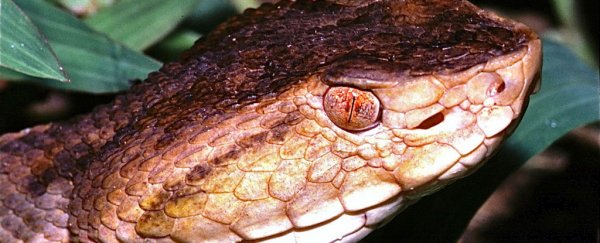Snake venom might not be top of your mind when it comes to handy medical aids to keep around the house, but new research could have you rethinking what's in your first aid kit.
Researchers at Rice University in the US have developed a new nanofibre hydrogel infused with snake venom that may amount to the most effective substance yet to stop bleeding quickly – especially since it works well even in the presence of anti-coagulant medications that thin the blood.
"It's interesting that you can take something so deadly and turn it into something that has the potential to save lives," says one of the team, chemist Jeffrey Hartgerink.
The hydrogel, called SB50, incorporates batroxobin, a type of venom produced by two species of pit viper found in South America – including the Brazilian lancehead (Bothrops moojeni) pictured above.
The coagulant properties of batroxobin have long been known, but fusing the venom with the hydrogel – which is composed of synthetic, self-assembling nanofibres – has produced an even faster-setting coagulant. Injected as a liquid to the site of a wound, the substance quickly thickens into a gel and conforms to the available space in the wound, promoting clotting in as little as 6 seconds in the researchers' tests.
The extremely fast action of the hydrogel could mean the difference between life and death for patients in emergency surgery – especially for those who take blood-thinning medications like heparin to prevent harmful clots forming in the veins, arteries or lungs.
"From a clinical perspective, that's far and away the most important issue here," said Hartgerink. "There's a lot of different things that can trigger blood coagulation, but when you're on heparin, most of them don't work, or they work slowly or poorly. That obviously causes problems if you're bleeding."
According to Hartgerink, heparin blocks the function of thrombin, an enzyme that helps our blood clot under normal circumstances (to prevent excessive bleeding from cuts or injuries). Batroxobin performs a similar function to thrombin, but it's not impeded by heparin – which could make it a life-saver for patients whose blood is too thin to clot without assistance.
"This is important because surgical bleeding in patients taking heparin can be a serious problem," said Hartgerink. "The use of batroxobin allows us to get around this problem because it can immediately start the clotting process, regardless of whether heparin is there or not."
Unfortunately, the hydrogel is expected to undergo several more years of testing before it can be approved for use as a therapeutic product. And interestingly enough, this isn't because of the snake venom. The batroxobin used in the hydrogel – which isn't taken directly from snakes, but is produced by genetically modified and purified bacteria – is already approved by the US FDA. The researchers' synthetic nanofibre gel, however, will require extensive testing before it's deemed safe for people to use for medical purposes.
The findings are published in ACS Biomaterials Science and Engineering.
